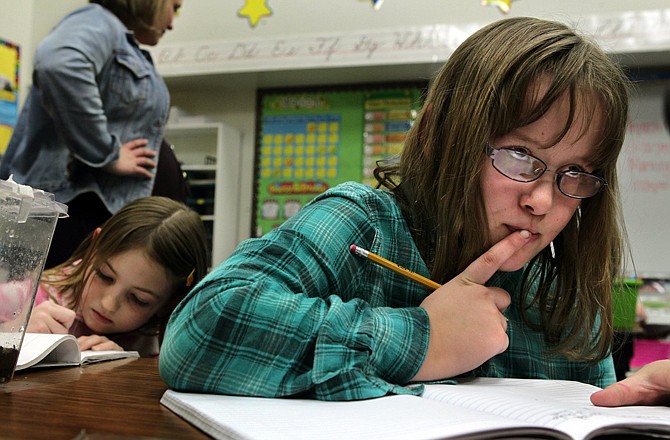ST. LOUIS (AP) - As the third-graders leaned over their notebooks with pencils pressed to paper, their teacher asked them to think about a time they were scared and then write about it.
In neatly printed words, Aaron Bennett wrote about getting stuck on a Ferris wheel with his friend Jack. A red label sits on top of his desk, with the letters of the alphabet in cursive, at Sorrento Springs Elementary in Ballwin. But printing, he said, "is just faster."
"I usually write my name in cursive," Bennett said. "But that's because I like to practice my signature."
Cursive is still taught in the Parkway School District and many districts in the St. Louis area. But at some schools elsewhere in the country, it's been eliminated from classroom teaching. Some worry that with the adoption of a national curriculum that doesn't mention cursive but includes keyboarding, learning script could be regarded as unnecessary in a digital era. And with the focus in recent years on tested subjects, the hours in the school day are precious.
It's a sign of the times that schools place less emphasis on cursive and handwriting in general, said Dan Domenech, executive director of the American Association of School Administrators, which recently gathered educators from around the nation to talk about the topic.
But researchers say handwriting helps children develop in other areas, such as reading, writing, memory and critical thinking. In one study by a cognitive neuroscience researcher at Indiana University, brain scans of children showed handwriting, not typing, sparked important brain activity.
"We are in a hurry to do away with basic skills because they can be replaced by technology," Domenech said. "What happens when technology doesn't work?"
Many states are in the process of adopting the Common Core State Standards, which attempt to set national guidelines for what students should learn and when. The standards are silent on handwriting and cursive. Missouri and Illinois adopted the standards in 2010.
The Missouri Department of Elementary and Secondary Education has left it to individual districts to make their own decisions on cursive. Students are expected to write legibly, but the specific word "cursive" is not used.
In many St. Louis area districts, cursive is still taught toward the end of second grade and into third grade, but students are not specifically graded on that skill. They are required to write legibly, whether that be printing or cursive. Basic letter formation is taught in kindergarten and practiced through second grade in most cases.
In the Rockwood School District, writing legible cursive is specifically mentioned in the curriculum for third, fourth and fifth grades, and students receive a grade for cursive on their report cards.
Matt Deichmann, spokesman for the Wentzville School District, said cursive is taught to provide students with an additional tool for writing. For some students, their cursive writing is more legible than their printing, Deichmann said.
The Parkway district is debating how to balance teaching handwriting and cursive with keyboarding or typing. The common core standards say fourth-grade students should learn keyboarding skills to type a minimum of one page in a single sitting with some guidance.
In Bennett's class, teacher Maureen Stasen typically has students writing most of their work by hand, and when they are ready to "publish" a story, they use the computer to type.
When keyboarding is taught in Parkway schools varies, and that's what curriculum coordinators are hoping to streamline.
"We'll figure out where we are going to guarantee time for instruction," said Lisa Meredith, Parkway's coordinator of elementary communication arts. "In education, you have to be careful of adding too many things."
The pressure to perform on state standardized tests in reading and math left some teachers in St. Louis Public Schools feeling as if there wasn't time to focus on handwriting. The district tried to emphasize handwriting in K-5 in the 2009-2010 school year but dropped the requirement for instructional time last year.
"Additional requirements just aren't in the cards when you are in an unaccredited district," said Paula Knight, associate superintendent for elementary schools. "And we are at a day and age where it is all technology driven."
But that doesn't mean handwriting isn't important, she said. Good teachers can find a way to build that into other subjects.
"I'm a strong believer in the correlation to handwriting and reading achievement," Knight said. "When I'm in schools and see some of the handwriting that's posted, sometimes it's hard to read."
A student's handwriting instruction often depends on the teacher or school. Two SLPS elementary schools, Buder and Mullanphy, are participating in the annual Zaner-Bloser National Handwriting Contest.
That contest has had a strong representation from Catholic schools, which are not bound to follow state standards and have a reputation for traditional education. "To be good writers, they have to be able to get their ideas on paper and be confident in their handwriting," said Karen Mason, a teacher at St. Joan of Arc Catholic School in St. Louis, which claims two previous statewide winners in the handwriting contest and is competing this year. Students are graded on cursive in third grade.
They also start learning keyboarding in kindergarten. "Neither one is not important," she said. "We focus on both."

